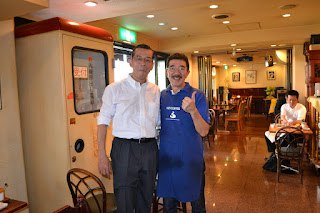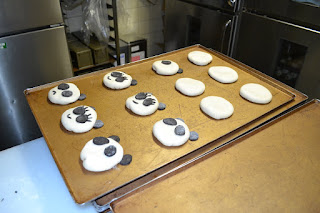If you go to Tokyo, and you have enough time between shopping and sightseeing, go and have a coffee at the Coffee House, also known as Coffee Ya. Why is that? No, not only because that's the place where I have worked for this month - even thought this should entitle to your visit without further hesitation. No, you should go because Tokyo is full of Coffee Shops where the Japanese go at any time of the day and night, to have a coffee, an ice tea, a chai tea latte, some panda shaped bread, or even pizza, risotto, curry beef and sandwiches. From breakfast to dinner, that's where the people of every age go, alone or with the family and friends, during a break from work, on Sunday morning or for lunch. Nothing says Tokyo more than a Coffee Shop, so if you really want to immerse yourself into the culture, go to a Coffee Shop, have something to eat and drink and just relax. Now, if this eulogy to these places have convinced you and you feel the urge to have an ice tea and grab a bite of a Panda Pan, then catch the chikatetsu, get to the Hanzomon Line, stays on board when, after Oshiage, it becomes the Tobu line, and get off at Hikifune. There's only one exit in Hikifune, get out of the station and turn right, and right again straight away. The Coffee House is right in front of you. With his dark red signs and big windowshops that give you a nice view of a huge variety of cakes, sweets, bread and treats in general you will feel a bit like in Honeydukes. And you won' be able to miss it. But if, for some strange reason that I ignore, I still haven't convinced you to go to the Coffee House for its mouthwatering delicacies, then you should go at least to meet Master, the owner. He is there all day long, always smiling, efficiently serving the customers and ready to joke and laugh with anybody. In Hikifune he is a sort of a legend, he knows everybody who counts and he is friends with everybody. And everybody loves him for his kind heart and gentle, polite ways. But also the waiters and the cooks are also a bunch of terrific people. If you are very lucky, you get to be served by Jennie, who is a Filipino who speaks Japanese, English and Tagalog extra well and laughs and smiles about everything; or maybe by Yukiko, who is cute and lovely, and looks at you from behind her big glasses that magnify her eyes in a manga way. And if you are even luckier you get to eat something cooked by Nae, who is a little young lady that goes back and forward between the kitchen and the coffee counter; because as good as she is she has to multitask to please the Master and the costumers. Or if you take a look at the kitchen and spot Akiko at work, you have to observe her calm and quiet way of making a mess and then fix everything as if nothing has happened. And you don't have to be lucky to eat the Panda Pan because they are freshly baked, like everything else in the shop, every morning. And if there are left overs on the shelves in the evening, they are either thrown away or given to friends the next morning. Nothing stays for more than 24 hours. So yeah, I think you should totally go, I'm sure they'll treat you well, like only in Japan. And eat the Panda Pan for me especially their heart of melting chocolate... yummy!
P.S. If for the title you see only little squares then it's time to abilitate your computer for the Asian script. Anyway, it says "Coffee House" in Japanese if you are wondering.
***
Se andate a Tokyo, ed avete abbastanza tempo tra lo shopping ed il turismo, andate a prendervi un caffè al Coffee House, anche conosciuto come Coffee Ya. Perché mai? No, non solo perché è il posto dove ho lavorato questo mese - anche se la notizia dovrebbe bastare a farvici andare senza esitazione. No, dovreste andarci perché Tokyo è piena di caffetterie affollate di giapponesi che ci stanno giorno e notte per prendersi un caffè, un té freddo, un chai tea latte, un po' di pane a forma di panda, o addirittura pizza, risotto, curry e panini. Dalla colazione alla cena, questo è il posto dove le persone di tutte le età vanno, da sole o con la famiglia e gli amici, durante una pausa dal lavoro, la domenica mattina o per pranzo. Niente dice Tokyo più di una caffetteria, quindi se davvero vi volete immergere nella cultura giapponese, andate in un caffè, prendetevi qualcosa da bere o da mangiare e rilassatevi. Ora, se questo elogio alle caffetterie vi ha convinto ed avete il bisogno di andare a prendervi un té freddo e un Panda Pan, prendete la chikatetsu, sulla linea Hanzomon, rimanete a bordo senza spaventarvi quando da Oshiage in poi diventa la linea Tobu e sbuca dal terreno e scendete ad Hikifune. C'è solo un'uscita ad Hikifune, uscite da lì (o buttatevi dai binari, a vostra scelta), girate a destra e poi di nuovo a destra. Il Coffee House è proprio davanti a voi. Con le sue insegne rosso porpora e le grandi vetrine che si aprono su un trionfo di torte, dolciumi, panini, varietà di pane, ed alte leccornie vi sentirete un po' come a Mielandia. E non lo potrete certo mancare. Ma se per qualche strana ragione che ignoro, ancora non vi ho convinti ad andare al Coffee House per i suoi appetitosi manicaretti , allora dovreste almeno andarci per incontrare Master, il proprietario. E' lì tutto il giorno, sempre sorridente, sempre a servire i clienti efficientemente, e pronto a ridere e scherzare con tutti. Ad Hikifune è un po' una leggenda, conosce tutti quelli che contano ed è amico di tutti. E tutti gli vogliono bene per la sua gentilezza, e per il grande cuore. Ma non solo; anche le cameriere e i cuochi sono un gruppetto di persone fantastiche. Se siete molto fortunati, verrete serviti da Jennie, una filippina che parla giapponese, inglese e tagalog benissimo e ride e sorride di tutto; o magari da Yukiko, che è deliziosamente carina ed adorabile, e ti guarda da dietro degli occhialoni che le ingrandiscono gli occhi come se fosse appena uscita da un manga. E se siete ancora più fortunati potrete mangiare qualcosa cucinato da Nae, che è una ragazza piccolina che si continua a spostare tra la cucina e il banco del caffé; perché è così brava che deve cercare di fare il multitasking per accontentare sia Master che i clienti. Se gettate un occhiata in cucina e vedete Akiko al lavoro, non smettete di osservare i suoi modi pacati e tranquilli mentre fa un casino e mentre poi riesce a rimettere tutto a posto con un sorriso come se niente fosse successo. E non dovete essere fortunati per potervi mangiare un Panda Pan, perché vengono fatti ed infornati, come tutte le cose nel caffé, tutti le mattine. E se ci sono cose avanzate sugli scaffali alla sera, vengono o buttate via o regalate agli amici il giorno dopo. Niente rimane nel negozio più di 24 ore. Quindi sì penso proprio che ci dovreste fare una capatina, sono sicura che vi tratteranno bene, come solo in Giappone sanno fare. E mangiatevi un Panda Pan per me, che con quel cuore di cioccolato fuso ti fa venire l'acquolina in bocca... slurp!
P.S. Se come titolo vedete solo dei quadratini, allora è il momento di abilitare i caratteri asiatici sul vostro computer. Comunque, dice "Coffee House" in giapponese in caso ve lo stiate chiedendo.
***
 The entrance to the Coffee House. - L'entrata del bar Coffee House.
The entrance to the Coffee House. - L'entrata del bar Coffee House.
***
 The delicacies on sale at the Coffee Shop. Don't they look delicious? - Le delizie in vendita al Coffee Shop. No vi sembrano appetitose?
The delicacies on sale at the Coffee Shop. Don't they look delicious? - Le delizie in vendita al Coffee Shop. No vi sembrano appetitose?
***
 The cakes. - Le torte.
The cakes. - Le torte.
***
 The Coffee House. - Il Coffee House.
The Coffee House. - Il Coffee House.
***

The kitchen. - La cucina.
***
 Master and a friend. - Master ed un amico.
Master and a friend. - Master ed un amico.
***
 Nae and Akiko, the Wednesday team. The BEST team. - Nae ed Akiko, il team del mercoledì. Il MIGLIOR team della settimana.
Nae and Akiko, the Wednesday team. The BEST team. - Nae ed Akiko, il team del mercoledì. Il MIGLIOR team della settimana.
***
 Jennie, can you believe that this woman is a Grandmother already? - Jennie, ci credete che è già nonna?
Jennie, can you believe that this woman is a Grandmother already? - Jennie, ci credete che è già nonna?
***
 Yukiko, kawaii, isn't she? - Yukiko, kawaii vero?
Yukiko, kawaii, isn't she? - Yukiko, kawaii vero?
***
 Group photo from the kitchen. Tomi, Nari, Nae, Akiko and me. - Foto di gruppo dalla cucina, Tomi, Nari, Nae, Akiko ed io.
Group photo from the kitchen. Tomi, Nari, Nae, Akiko and me. - Foto di gruppo dalla cucina, Tomi, Nari, Nae, Akiko ed io.
***

The making of the Panda Pan. Part 1. - La creazione del Panda Pan. Parte 1.
***

The making of the Panda Pan. Part 2. - La creazione del Panda Pan. Parte 2.
***

Panda Pan. - I Panda Pan.



 The kitchen. - La cucina.
The kitchen. - La cucina.




 The making of the Panda Pan. Part 1. - La creazione del Panda Pan. Parte 1.
The making of the Panda Pan. Part 1. - La creazione del Panda Pan. Parte 1. The making of the Panda Pan. Part 2. - La creazione del Panda Pan. Parte 2.
The making of the Panda Pan. Part 2. - La creazione del Panda Pan. Parte 2. Panda Pan. - I Panda Pan.
Panda Pan. - I Panda Pan.

































